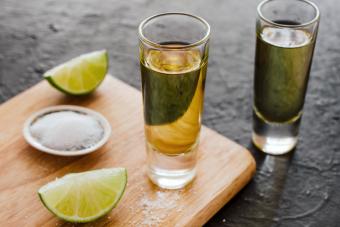
As with anything in life, when playing in the cocktail world, you must first know the rules before you can play the game-- and then bend the rules as you see fit. For alcohol, this means learning the different standard drink measurements. All of this depends on the style of cocktail, in addition to the standard pours of beer and wine.
Standard Liquor and Mixed Drink Pours
Liquor probably has the most options when it comes to varying standard pours. This standard pour is often a "four-count," meaning a four-second pour. This count will change depending on the style of drink, as a shot will have a different total than a drink served neat, as will a mixed drink in comparison to a martini.
A margarita will have roughly two ounces of alcohol, but a hurricane would come closer to four ounces. Similarly, a standard gin martini or Manhattan would have 2 to 2½ ounces of spirits, but a vesper would run closer to four ounces. If you order a shot of whiskey at a bar, you'll receive 1½ ounces of whiskey. But if you opt for whiskey neat or on the rocks, the bartender will hand you a glass with two ounces of whiskey.
Standard Beer and Cider Pours
When it comes to hard cider or beer, different styles of beer, including the abv or alcohol by volume, will influence how much the bartender serves you. Most beers are a standard 12 ounces throughout America, although some countries and bars err on the side of 16 ounces. For beers that pack a bigger punch, such as double or triple IPAs, some Belgian style beers, stouts, porters, or other specialty beers with higher ABV. A snifter, chalice, or tulip glass are the most popular glassware styles for these beers as they are most appropriate for the 10 ounce serving size for those beers.
Hard cider, like beer, has a range of least to most boozy, with most cider having a lower abv of 4.5% to those with a boozier kick at 8.5% or more. This means the standard pour of cider can range from 12 to 16 ounces for those on the lower end. For the boozier ciders, you would only have a 10-ounce pour. Likewise, mead, or "honey wine," is typically 12% but can run higher or lower, depending on the meadery or style. Because of this higher abv, mead is usually a 5-ounce serving, although meads that aren't as boozy could be 10 to 12-ounce servings.
Standard Wine Pours
A wine typically runs between 6% and 16% ABV, although it averages closer to 12%. With the 12% average ABV, it's no wonder a standard wine pour is five ounces. If you don't want to continually use a jigger or shot glass to measure wine, there are a few easy ways to visually measure a standard pour of wine. Once you measure a 5-ounce pour into a standard or typical wine glass, you'll notice that the pour stops right where the curve of the glass starts to straighten out. If you're serving a full bottle, you'll notice that it holds four servings of wine. Over time, it becomes easier to eyeball. Anything over a standard pour is an industry pour.
Understanding Standard Drink Measurements
So why the standard drink measurements? The primary purpose of a standard drink measurement isn't about the taste of a cocktail. A standard drink measurement is the size of a pour that contains 14 grams of pure alcohol, or 0.6 ounces. As different spirits and alcohol will vary in ABV, the pour size will vary as well. You should note that serving sizes vary from standard pour sizes, as anyone who has had a martini or mixed drink from two different bars or even two different bartenders can attest.

Standard Drink Measurements and You
The easiest way to measure a drink if you don't have a spout on liquor is to use a jigger or even a shot glass. Luckily, most beer, ciders, and meads will tell you how much is inside so it's easy to decipher a standard pour. For wine, it's often where the glass starts to straighten out its curve-- although a large wine glass might be deceiving. Once you learn the ropes and can visually see how much you need to use, you'll be eyeballing your drink measurements in no time.







